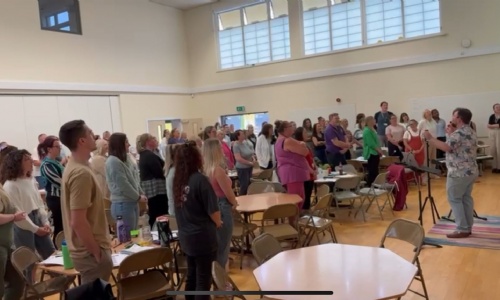Leading by Example: The Joy of Singing

This week started with two teacher training days - a time for us as educators to step back, challenge our thinking, and expand our understanding of how children learn. Usually, these sessions kick off with an icebreaker: maybe a guest speaker or a team-building activity. This year, though, things were a bit different.
Imagine it: the first day back after a six-week break, Monday morning, 8:30 a.m. What’s the last thing you’d expect to be doing? Probably communal singing - but that’s exactly what we did.
Over the summer holidays, I was tasked with creating and leading a 15-minute workshop on getting 130 reluctant, self-proclaimed "non-singers" to sing together… as a choir. No small feat. As I stood in front of the room and saw the initial groans ripple across the staff - who were from both Mayflower and Ford - I knew I was about to face one of my toughest ‘gigs’ to date. But despite the palpable discomfort in the room, I held onto my belief in the power of singing. Once they got into it, I was certain they’d not only enjoy themselves but also gain real value from the experience.
There’s something special about singing that goes far beyond the technical ability to hit the right notes. For me, this workshop wasn’t just about teaching people to sing well; it was about conveying a deeper message. Singing has always been a tool for building togetherness, and our school’s motto—*‘Together we can’*—resonated perfectly with that.
As I meet more people, I notice that something has been lost. Once a shared joy during celebrations, work, or moments of reflection, singing now seems reserved for a select few. There’s this prevailing idea that only those who *can* sing, *should* sing. But I reject that notion wholeheartedly. Singing isn’t for the elite. It’s for everyone. And I’ve made it my mission to help as many people as possible rediscover the joy of singing - and feel comfortable doing it.
Sure, we’ve all seen the stars on YouTube and TikTok, those who’ve honed their craft to perfection. But here’s the truth: you don’t need to be at that level to find joy, confidence, or meaning in singing. For me, it’s not about getting every note perfect (though that’s nice). It’s about expressing emotion, connecting with ourselves and others, and building community. Singing brings us together in ways that few other activities can.
For those of us in education, especially those involved in early development, our voices are powerful tools. When we encourage children to sing and help them build confidence from a young age, we open doors to a world of social and musical understanding. Singing becomes a gateway to a richer life, filled with music and a deeper sense of belonging. But to pass this gift on to our students, we must first embrace it ourselves. And more than anything, we need to remember how to have fun with it.
The workshop itself was built around nursery rhymes, using them as partner songs to help the group learn how to harmonise. It seemed like an obvious starting point. Nursery rhymes are familiar and comforting, especially for those who feel self-conscious about singing. From a musical perspective, they also work beautifully as rounds, canons, and partner songs - perfect for teaching basic harmonisation with minimal pressure.
Partner songs are simple: you learn two melodies that work together harmonically and then layer them on top of each other. When done right, they sound amazing with very little effort. We used "Are You Sleeping?" and "Three Blind Mice" for the exercise. After everyone had learnt the two songs separately, we layered them. And to the group’s amazement - it worked! Many of them had just harmonised for the first time in their lives, and it sounded incredible. When we finished, there was a collective ‘wow’ and applause that rippled through the room, as the staff realised what they had just achieved. It was a magical moment.
As adults, it’s easy to forget what it feels like to learn something entirely new, especially something outside our comfort zones. This is the feeling our students experience every day. For many, the fear of doing something unfamiliar can be paralysing, so much so that they might avoid participating at all. But when you scaffold the experience in the right way, lead by example, make it fun, and help students appreciate their progress, you create moments of learning they’ll remember forever.
Sometimes, we need to be brave and just give things a go. Because when we do, we often realise we’re capable of far more than we initially thought. And that’s a lesson worth sharing.
